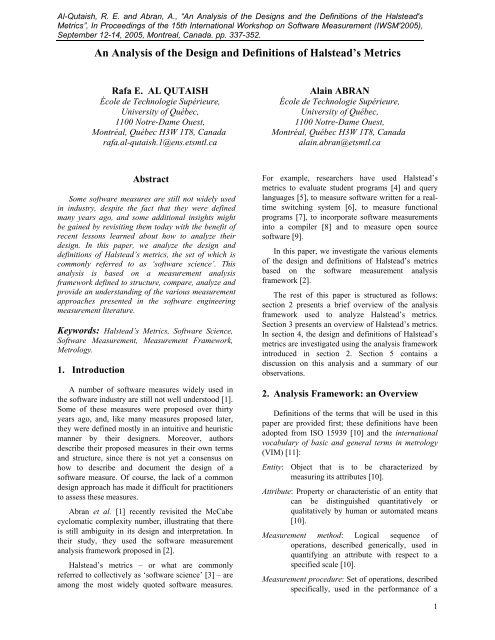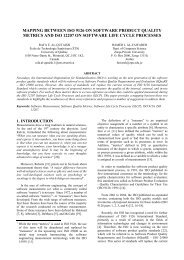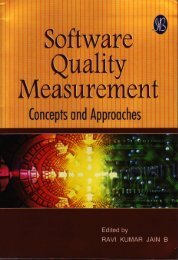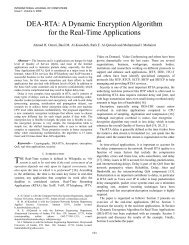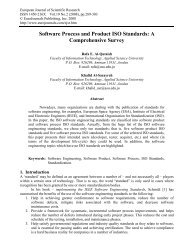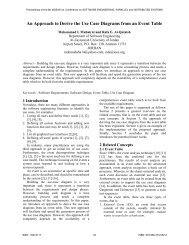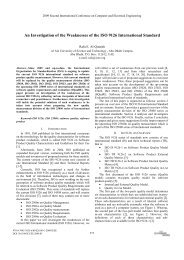An Analysis of the Design and Definitions of Halstead's Metrics
An Analysis of the Design and Definitions of Halstead's Metrics
An Analysis of the Design and Definitions of Halstead's Metrics
Create successful ePaper yourself
Turn your PDF publications into a flip-book with our unique Google optimized e-Paper software.
n 1 : Number <strong>of</strong> distinct operators.n 2 : Number <strong>of</strong> distinct oper<strong>and</strong>s.N 1 : Total number <strong>of</strong> occurrences <strong>of</strong> operators.N 2 : Total number <strong>of</strong> occurrences <strong>of</strong> oper<strong>and</strong>s.In addition to <strong>the</strong> above, Halstead defines [3]:n * 1 : Number <strong>of</strong> potential operators.n * 2 : Number <strong>of</strong> potential oper<strong>and</strong>s.Halstead refers to n * 1 <strong>and</strong> n * 2 as <strong>the</strong> minimumpossible number <strong>of</strong> operators <strong>and</strong> oper<strong>and</strong>s for amodule or a program respectively. This minimumnumber would occur in a programming languageitself, in which <strong>the</strong> required operation already existed(for example, in C language, any program mustcontain at least <strong>the</strong> definition <strong>of</strong> <strong>the</strong> function main()),possibly as a function or as a procedure; in such acase, n * 1 =2, since at least two operators must appearfor any function or procedure: one for <strong>the</strong> name <strong>of</strong> <strong>the</strong>function <strong>and</strong> one to serve as an assignment orgrouping symbol. Next, n * 2 represents <strong>the</strong> number <strong>of</strong>parameters, without repetition, which would need tobe passed on to <strong>the</strong> function or <strong>the</strong> procedure [14].All <strong>of</strong> <strong>the</strong> <strong>Halstead's</strong> so called "S<strong>of</strong>tware Science"metrics are defined based on <strong>the</strong> above collectivemeasures (n 1 , n 2 , N 1 , N 2 , n * 1 <strong>and</strong> n * 2 ).Halstead defines <strong>the</strong> following metrics [3]:- The length (N) <strong>of</strong> a program P is:N = N1 + N 2.(1)- The vocabulary (n) <strong>of</strong> a program P is:n = n1 + n 2.(2)- Program volume (V) is defined by Halstead inhis book as:a) a suitable metric for <strong>the</strong> size <strong>of</strong> anyimplementation <strong>of</strong> any algorithm; 1b) a count <strong>of</strong> <strong>the</strong> number <strong>of</strong> mentalcomparisons required to generate aprogram. 2V can be computed using <strong>the</strong> followingequation:V = N *log2 n.(3)The length, <strong>the</strong> vocabulary <strong>and</strong> volume <strong>of</strong> aprogram are considered as reflecting differentviews <strong>of</strong> program size [15].- Program potential (minimal) volume (V * ), whichis <strong>the</strong> volume <strong>of</strong> <strong>the</strong> minimal sizeimplementation <strong>of</strong> a program P, is defined as 3 :1 Halstead’s book [3], p. 19.2 Halstead’s book [3], p. 47.3 No objective evidence documented in [3] that this isindeed a minimal implementation.V*= (2 + n*) log (2 + n* 2 2 2 ). (4)- Program level (L) <strong>of</strong> a program P with volume Vis:V*L = .(5)VThe program level emphasizes that growth involume leads to a lower level <strong>of</strong> program, <strong>and</strong>conversely. The largest value for L is 1. Inaddition, this value is interpreted as referring to<strong>the</strong> most ideally written program <strong>and</strong> asmeasuring how well written a program is. Thus,programs with L values close to 1 areconsidered to be well written, in general L
where S is <strong>the</strong> Stroud number 1 , defined as <strong>the</strong>number <strong>of</strong> elementary discriminationsperformed by <strong>the</strong> human brain per second. The Svalue for s<strong>of</strong>tware scientists is set to 18 [17].The unit <strong>of</strong> measurement <strong>of</strong> T is <strong>the</strong> second.All <strong>the</strong> above ten equations are based on <strong>the</strong>results <strong>of</strong> n 1 , n 2 , N 1 , N 2 , n * 1 <strong>and</strong> n * 2 , which<strong>the</strong>mselves are based on a counting strategy toclassify <strong>the</strong> program tokens as operators or oper<strong>and</strong>s.Unfortunately, <strong>the</strong>re is a problem in distinguishingbetween operators <strong>and</strong> oper<strong>and</strong>s. This problem occursbecause Halstead has provided an example 2 withspecific illustrations <strong>of</strong> operators <strong>and</strong> oper<strong>and</strong>s, butwithout generic definitions applicable to any programcontext. That is, Halstead has not explicitly described<strong>the</strong> generic measurable concepts <strong>of</strong> operators <strong>and</strong>oper<strong>and</strong>s. He has asserted only that – in <strong>the</strong> examplehe provides – <strong>the</strong>ir description is intuitively obvious<strong>and</strong> requires no fur<strong>the</strong>r explanation. In practice, formeasurement purposes, intuition is insufficient toobtain accurate, repeatable <strong>and</strong> reproduciblemeasurement results.Therefore, it is important that <strong>the</strong> countingstrategy be clearly defined <strong>and</strong> consistent, since allHalstead’s s<strong>of</strong>tware science depends on counts <strong>of</strong>operators <strong>and</strong> oper<strong>and</strong>s [18]. However, <strong>the</strong>re is nogeneral agreement among researchers on <strong>the</strong> mostmeaningful way to classify <strong>and</strong> count <strong>the</strong>se tokens[19]. Hence, individual researchers (<strong>and</strong> practitionersas well) must state <strong>the</strong>ir own interpretation or,alternatively, use one <strong>of</strong> <strong>the</strong> available countingstrategies proposed by o<strong>the</strong>r researchers, such as in[20-23]. Fur<strong>the</strong>rmore, Li et al. have proposed rulesfor identifying operators <strong>and</strong> oper<strong>and</strong>s in <strong>the</strong> objectorientedprogramming (OOP) languages [24].Of course, it is to be expected that differentcounting strategies will produce different values <strong>of</strong> n 1 ,n 2 , N 1 <strong>and</strong> N 2, <strong>and</strong>, consequently, different values for<strong>the</strong> above ten equations.4. <strong>An</strong>alysis <strong>of</strong> <strong>the</strong> <strong>Design</strong> <strong>and</strong> <strong>Definitions</strong><strong>of</strong> Halstead’s <strong>Metrics</strong>4.1. Defining <strong>the</strong> ContextThe objective <strong>of</strong> Halstead’s metrics is to measure<strong>the</strong> following characteristics <strong>of</strong> a program: length,vocabulary, volume, level, difficulty <strong>and</strong> intelligence1 In 1967, a psychologist, John M. Stroud, suggestedthat <strong>the</strong> human mind is capable <strong>of</strong> making a limitednumber <strong>of</strong> mental discrimination per second (StroudNumber), in <strong>the</strong> range <strong>of</strong> 5 to 20.2 Halstead’s book [3], pp. 6-8.content. In addition, <strong>the</strong>y are used to measuring whatis referred to as “o<strong>the</strong>r characteristics” <strong>of</strong> <strong>the</strong>developer: programming effort <strong>and</strong> requiredprogramming time. All <strong>the</strong>se measures are based onlyon <strong>the</strong> number <strong>of</strong> operators <strong>and</strong> <strong>the</strong> number <strong>of</strong>oper<strong>and</strong>s <strong>the</strong> given program or algorithm contains.The last two attributes, which refer to adeveloper’s attributes (programming effort <strong>and</strong>required programming time), seem to be identical,since ‘effort to write a program’ is similar to‘required programming time’.4.2. <strong>Design</strong>ing <strong>the</strong> measurement4.2.1. The empirical <strong>and</strong> numerical worlds <strong>and</strong><strong>the</strong>ir mappingThe entities that can be used to apply Halstead’smetrics are <strong>the</strong> source code itself or <strong>the</strong> algorithm <strong>of</strong>that source code. However, applying Halstead’smetrics to <strong>the</strong>se two entities will produce differentvalues for <strong>the</strong> same base measures. For example, inJava language, <strong>the</strong> number <strong>of</strong> operators in <strong>the</strong> sourcecode is different from <strong>the</strong> number <strong>of</strong> operators in <strong>the</strong>equivalent algorithm for that source code, since – asan example – in Java source code, each statementmust be end with a semicolon (;), which is anoperator.Halstead’s metrics are based on two attributes: <strong>the</strong>number <strong>of</strong> operators <strong>and</strong> <strong>the</strong> number <strong>of</strong> oper<strong>and</strong>s. Asmentioned in section 3, <strong>the</strong>re is no agreement on howto distinguish between operators <strong>and</strong> oper<strong>and</strong>s.Therefore, different counting strategies will producedifferent numbers <strong>of</strong> operators <strong>and</strong> oper<strong>and</strong>s for <strong>the</strong>same program or algorithm. The two attributes can beeasily mapped to a ma<strong>the</strong>matical structure bycounting <strong>the</strong> number <strong>of</strong> operators <strong>and</strong> oper<strong>and</strong>s in <strong>the</strong>program source code or <strong>the</strong> equivalent algorithm.Fur<strong>the</strong>rmore, Kiricenko <strong>and</strong> Orm<strong>and</strong>jieva [25]investigated <strong>the</strong> validation <strong>of</strong> <strong>the</strong> representationcondition for Halstead’s program length metric.4.2.2. The measurement methodTo obtain a value for each <strong>of</strong> Halstead’s metrics,ten equations have to be computed (see section 3). Itis to be noted that all <strong>of</strong> <strong>the</strong>se equations (equations 1to 10) correspond to a ‘derived measure’, as definedby <strong>the</strong> international vocabulary <strong>of</strong> basic <strong>and</strong> generalterms in metrology (VIM) <strong>and</strong> <strong>the</strong> ISO 15939.Equation (3) is <strong>of</strong> a ratio scale type, whileequation (5) is <strong>of</strong> an ordinal scale type, as noted byFenton <strong>and</strong> Pfleeger [16]. By contrast, Zuse [26]maintains that equation (1) is <strong>of</strong> <strong>the</strong> ratio scale type4
<strong>and</strong> equations (2), (3), (6) <strong>and</strong> (9) are <strong>of</strong> an ordinalscale type. Moreover, it can be observed that equation(4) is also <strong>of</strong> <strong>the</strong> ratio scale type. However, it is notclear to which scale type equations (7), (8) <strong>and</strong> (10)belong.These conclusions on <strong>the</strong> scale types <strong>of</strong> Halstead’smetrics need to be revisited when <strong>the</strong> units <strong>of</strong>measurement in Halstead’s equations are taken intoconsideration.For instance, in equation (1), <strong>the</strong> program length(N) is calculated by <strong>the</strong> addition <strong>of</strong> <strong>the</strong> total number<strong>of</strong> occurrences <strong>of</strong> operators <strong>and</strong> <strong>the</strong> total number <strong>of</strong>occurrences <strong>of</strong> oper<strong>and</strong>s. However, since <strong>the</strong>ir unitsare different, operators <strong>and</strong> oper<strong>and</strong>s cannot bedirectly added toge<strong>the</strong>r unless <strong>the</strong> concept common to<strong>the</strong>m (<strong>and</strong> its related unit) is taken into considerationin <strong>the</strong> addition <strong>of</strong> <strong>the</strong>se numbers, that is, ‘occurrences<strong>of</strong> tokens’: <strong>the</strong>n, <strong>the</strong> right-h<strong>and</strong> side <strong>of</strong> equation (1)gives ‘occurrences <strong>of</strong> tokens’ as a measurement uniton <strong>the</strong> ratio scale:occurrences occurrences occurrences<strong>of</strong> tokens <strong>of</strong> operators <strong>of</strong> oper<strong>and</strong>sN= N+ N.12From equation (2), <strong>the</strong> program vocabulary (n)can be constructed by adding <strong>the</strong> number <strong>of</strong> distinctoperators <strong>and</strong> <strong>the</strong> number <strong>of</strong> distinct oper<strong>and</strong>s:distinct distinct distincttokens operators oper<strong>and</strong>sn = n1+ n 2 .The measurement unit here is ‘distinct tokens’. Thismeasurement unit must <strong>the</strong>n also be assigned to <strong>the</strong>left-h<strong>and</strong> side <strong>of</strong> this equation, labeled ‘vocabulary’,<strong>and</strong> associating it to <strong>the</strong> related concepts.It can be noted that, while <strong>the</strong> concept <strong>of</strong> ‘length’is associated with a number, <strong>the</strong> concept <strong>of</strong>‘vocabulary’ is not. Indeed, <strong>the</strong> program vocabulary(n) reflects a different view <strong>of</strong> program size [15], <strong>and</strong>it is a measure <strong>of</strong> ‘<strong>the</strong> repertoire <strong>of</strong> elements that aprogrammer must deal with to implement <strong>the</strong>program’ [27]. Most probably, an expression such as‘size <strong>of</strong> a vocabulary’ would have been moreappropriate.From equation (3), program volume (V) has beeninterpreted with two different units <strong>of</strong> measurement;‘<strong>the</strong> number <strong>of</strong> bits required to code <strong>the</strong> program’[17] <strong>and</strong> ‘<strong>the</strong> number <strong>of</strong> mental comparisons neededto write <strong>the</strong> program’ [14] on <strong>the</strong> left-h<strong>and</strong> side <strong>of</strong> <strong>the</strong>equation:Vbitsormentalcomparisonsoccurrences distinct<strong>of</strong> tokenstokens= N * log2n .Thus, <strong>the</strong>re is no relationship between <strong>the</strong>measurement unit on <strong>the</strong> left-h<strong>and</strong> side <strong>and</strong> those on<strong>the</strong> right-h<strong>and</strong> side <strong>of</strong> this equation. Fur<strong>the</strong>rmore, on<strong>the</strong> right-h<strong>and</strong> side, <strong>the</strong> true meaning <strong>of</strong> <strong>the</strong>multiplication <strong>of</strong> ‘occurrences <strong>of</strong> tokens’ <strong>and</strong> ‘distincttokens’ is not clear. Such a multiplication wouldnormally produce a number without a measurementunit, see Fig. 2.In general, in engineering applications we do nottake <strong>the</strong> logarithm <strong>of</strong> a dimensioned number, only<strong>of</strong> dimensionless quantities. For instance, incalculating decibels, we take <strong>the</strong> logarithm <strong>of</strong> aratio <strong>of</strong> two quantities. A ratio <strong>of</strong> quantities with<strong>the</strong> same dimensions is itself dimensionless. Wecan writelog(a/b) = log(a) - log(b)making it appear that we are taking <strong>the</strong> logs <strong>of</strong>dimensioned quantities (a) <strong>and</strong> (b), but <strong>the</strong>dimensions come out in <strong>the</strong> wash: by <strong>the</strong> time wehave finished (subtracting one log from <strong>the</strong>o<strong>the</strong>r), we have effectively taken <strong>the</strong> log <strong>of</strong> adimensionless quantity, (a/b).We can regard units as factors in an expression,for instance:8 meters = 8 * [1 meter]800 cm = 800 * [1 cm]= 800 * 0.01 * [1 meter]In <strong>the</strong>se terms, we have:(8m)*log 2 (8m) = 8*[1m]*log 2 (8*[1m])= 8*[1m]*(log 2 (8)+log 2 [1m])= (8*log 2 (8)+8*log 2 [1m])*[1m]That inconvenient 8*log 2 [1m] is an additive termthat depends on <strong>the</strong> units being used. If it is part<strong>of</strong> a valid engineering calculation, this term willbe canceled out somewhere in <strong>the</strong> process. It maybe, for instance, that when we take <strong>the</strong> log <strong>of</strong> 8meters, we are actually taking <strong>the</strong> log <strong>of</strong> a ratio <strong>of</strong>8 meters to a one-meter st<strong>and</strong>ard length.Fig. 2: Explanation <strong>of</strong> <strong>the</strong> measurement unitproduced by log 1 2 .Equation (4) gives <strong>the</strong> definition <strong>of</strong> <strong>the</strong> programpotential volume (V * ), which is a prediction <strong>of</strong> <strong>the</strong>program volume:1 Contact by e-mail with Mr. Richard Peterson, TheMath Forum (Ask Dr. Math) at Drexel University,http://www.mathforum.org/dr.math/.5
*V = (2potentialoperators*+ n 2potentialoper<strong>and</strong>s) log2(2potentialoperators*+ n 2potentialoper<strong>and</strong>sIn this equation, <strong>the</strong> value ‘2’ was assigned to n * 1 , asseen in section 3. The measurement unit <strong>of</strong> <strong>the</strong> lefth<strong>and</strong>side is <strong>the</strong> same as in <strong>the</strong> previous equation(equation (3)), while <strong>the</strong>re is no recognizablemeasurement unit for <strong>the</strong> right-h<strong>and</strong> side. As inequation (3), such a multiplication would alsonormally produce a number without a measurementunit, see Fig. 2.The program level (L) can be calculated usingequation (5), in which <strong>the</strong>re is no measurement unitfor <strong>the</strong> left h<strong>and</strong>-side, ei<strong>the</strong>r from Halstead himself orfrom o<strong>the</strong>r researchers. In <strong>the</strong> sense that this is <strong>the</strong>correct structure for a ratio with <strong>the</strong> same unit in bothnumerator <strong>and</strong> denominator; <strong>the</strong> end result is<strong>the</strong>refore a percentage:bits mental comparisonsV*V*L = =.VbitsVmental comparisonsFor equation (6), <strong>the</strong> difficulty (D) is a measure <strong>of</strong>‘ease <strong>of</strong> reading’ <strong>and</strong> can be seen as a measure <strong>of</strong>‘ease <strong>of</strong> writing’ as well [27]. The right-h<strong>and</strong> side isalso a percentage. What <strong>the</strong> right-h<strong>and</strong> side <strong>of</strong>equation (6) means is a riddle, as its associated labelon <strong>the</strong> left-h<strong>and</strong> side.In Equation (7), for <strong>the</strong> program level estimator(Lˆ ), <strong>the</strong>re is no measurement unit for <strong>the</strong> left-h<strong>and</strong>side, while <strong>the</strong> right-h<strong>and</strong> side consists <strong>of</strong> acombination <strong>of</strong> four distinct measurement units. Theexact meaning is again a riddle:potential distinctoperators oper<strong>and</strong>s2n 2Lˆ = *.distinct occurrencesoperators <strong>of</strong> oper<strong>and</strong>sn N12In equation (8), referred to as <strong>the</strong> intelligentcontent <strong>of</strong> <strong>the</strong> program (I), <strong>the</strong>re is no measurementunit on <strong>the</strong> left-h<strong>and</strong> side. For <strong>the</strong> right-h<strong>and</strong> side <strong>of</strong>this equation, <strong>the</strong> measurement unit <strong>of</strong> Lˆ – which isnot known since it is a combination <strong>of</strong> units – ismultiplied by <strong>the</strong> measurement unit <strong>of</strong> V:I =bits mental comparisonsLˆ *V = Lˆ *V.As for equations (6) <strong>and</strong> (7), <strong>the</strong> exact meaning <strong>of</strong><strong>the</strong> left-h<strong>and</strong> side <strong>of</strong> equation (8) is a riddle if weattempt to interpret this number with measurementunits.Equation (9) is used by Halstead to compute <strong>the</strong>effort (E) required to generate a program:).Eelementarymentaldiscriminationsn1=distinctoperatorsoccurrences<strong>of</strong>oper<strong>and</strong>sN2N2potentialoperatorsn2occurrences<strong>of</strong>tokensdistinctoper<strong>and</strong>sdistincttokenslog 2 n.The measurement unit <strong>of</strong> <strong>the</strong> left-h<strong>and</strong> side <strong>of</strong> thisequation, referred to as ‘effort’, would be expected tobe something such as ‘hours’ or ‘days’. Halstead,however, referred to ‘<strong>the</strong> number <strong>of</strong> elementarymental discriminations’ as <strong>the</strong> unit <strong>of</strong> measurementfor <strong>the</strong> left-h<strong>and</strong> side. Next, in <strong>the</strong> sense that <strong>the</strong>‘distinct operators’, <strong>the</strong> ‘distinct oper<strong>and</strong>s’ <strong>and</strong> <strong>the</strong>‘occurrences <strong>of</strong> oper<strong>and</strong>s’ are, in a generic sense,‘tokens’, <strong>the</strong>n it can be concluded that <strong>the</strong>measurement unit <strong>of</strong> <strong>the</strong> right h<strong>and</strong>-side <strong>of</strong> thisequation is a combination <strong>of</strong> measurement units.Therefore, <strong>the</strong>re is no relationship between <strong>the</strong> units<strong>of</strong> measurement <strong>of</strong> <strong>the</strong> left-h<strong>and</strong> <strong>and</strong> <strong>the</strong> right-h<strong>and</strong>sides in equation (9).Finally, equation (10) is used to compute <strong>the</strong>required programming time (T) for <strong>the</strong> program:distinctoperatorsn 1Tseconds=occurrences<strong>of</strong>oper<strong>and</strong>sN 2potentialoperators2psychologicalmomentspersecond18occurrences<strong>of</strong>distincttokenstokensNlog 2 n.distinctoper<strong>and</strong>sn 2Again, <strong>the</strong> measurement unit <strong>of</strong> <strong>the</strong> left-h<strong>and</strong> side,that is, seconds, does not in any way imply <strong>the</strong>measurement unit <strong>of</strong> <strong>the</strong> right-h<strong>and</strong> side, that is, acombination <strong>of</strong> many different measurement units. Inview <strong>of</strong> <strong>the</strong> fact that, Halstead refers to <strong>the</strong> ‘moments’in this equations as “<strong>the</strong> time required by <strong>the</strong> humanbrain to perform <strong>the</strong> most elementarydiscrimination” 1 .5. Discussion <strong>and</strong> ConclusionsIn this paper, we have investigated a well-knownset <strong>of</strong> measures – Halstead’s metrics – by focusing on<strong>the</strong>ir design <strong>and</strong>, in particular, on <strong>the</strong>ir measurementunits. The following comments can be made aboutHalstead’s metrics:- Based on ISO 15939 [10] <strong>and</strong> <strong>the</strong> internationalvocabulary <strong>of</strong> basic <strong>and</strong> general terms inmetrology (VIM) [11], Halstead’s metrics can beclassified as six based measures (n 1 , n 2 , N 1 , N 2 ,n * 1 <strong>and</strong> n * 2 ) <strong>and</strong> ten derived measures (equations(1) to (10)).- Halstead has not explicitly provided a clear <strong>and</strong>complete counting strategy to distinguish between<strong>the</strong> operators <strong>and</strong> <strong>the</strong> oper<strong>and</strong>s in a given programor algorithm. This has led researchers to come up1 Halstead’s book [3], p. 48.6


